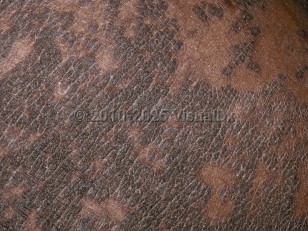Confluent and reticulated papillomatosis in Adult
Alerts and Notices
Important News & Links
Synopsis

Confluent and reticulated papillomatosis (CARP), also known as confluent and reticulated papillomatosis of Gougerot and Carteaud or Gougerot-Carteaud syndrome, is a rare cutaneous dermatosis of undetermined etiology with clinical features resembling acanthosis nigricans and tinea versicolor. It has been speculated that the disorder may be due to an endocrine disturbance, abnormal keratinocyte differentiation and maturation, an abnormal host reaction to bacteria or fungi, or that it may be hereditary. Onset is usually at puberty, but the age range of those affected has been reported to be 5-63 years.
CARP is clinically characterized by brown, hyperkeratotic or verrucous, thin papules that usually affect the upper central trunk and axillae. These papules coalesce into reticulated plaques. The lesions are usually asymptomatic but may be pruritic. The disorder typically affects adolescents. Black individuals and individuals who are overweight or obese may be more commonly affected. While responsive to treatment, the disease is usually chronic and marked by exacerbations and remissions. In one retrospective study, while patients who received oral antibiotics improved with therapy, one-half presented with a flare within 1-2 years of treatment. CARP may be associated with acanthosis nigricans, a finding that has been particularly noted in Black individuals who are obese. In this setting, CARP has been reported to be more difficult to treat.
Diagnostic criteria have been proposed by Davis et al (Ann Dermatol. 2014 Jun;26[3]:409-410) due to frequent misdiagnosis of this condition and include the following: (i) clinical findings include scaly brown macules and patches, with at least some appearing reticulated and papillomatous; (ii) involvement of the upper trunk and neck; (iii) negative fungal staining of the scales; (iv) no response to antifungal treatment; and (v) excellent response to minocycline. A second research group proposed revised criteria to include clinical involvement of the flexural areas and management with antibiotics, rather than minocycline specifically.
CARP is clinically characterized by brown, hyperkeratotic or verrucous, thin papules that usually affect the upper central trunk and axillae. These papules coalesce into reticulated plaques. The lesions are usually asymptomatic but may be pruritic. The disorder typically affects adolescents. Black individuals and individuals who are overweight or obese may be more commonly affected. While responsive to treatment, the disease is usually chronic and marked by exacerbations and remissions. In one retrospective study, while patients who received oral antibiotics improved with therapy, one-half presented with a flare within 1-2 years of treatment. CARP may be associated with acanthosis nigricans, a finding that has been particularly noted in Black individuals who are obese. In this setting, CARP has been reported to be more difficult to treat.
Diagnostic criteria have been proposed by Davis et al (Ann Dermatol. 2014 Jun;26[3]:409-410) due to frequent misdiagnosis of this condition and include the following: (i) clinical findings include scaly brown macules and patches, with at least some appearing reticulated and papillomatous; (ii) involvement of the upper trunk and neck; (iii) negative fungal staining of the scales; (iv) no response to antifungal treatment; and (v) excellent response to minocycline. A second research group proposed revised criteria to include clinical involvement of the flexural areas and management with antibiotics, rather than minocycline specifically.
Codes
ICD10CM:
L83 – Acanthosis nigricans
SNOMEDCT:
89987007 – Confluent AND reticulate papillomatosis
L83 – Acanthosis nigricans
SNOMEDCT:
89987007 – Confluent AND reticulate papillomatosis
Look For
Subscription Required
Diagnostic Pearls
Subscription Required
Differential Diagnosis & Pitfalls

To perform a comparison, select diagnoses from the classic differential
Subscription Required
Best Tests
Subscription Required
Management Pearls
Subscription Required
Therapy
Subscription Required
References
Subscription Required
Last Reviewed:05/04/2024
Last Updated:05/05/2024
Last Updated:05/05/2024
Confluent and reticulated papillomatosis in Adult

